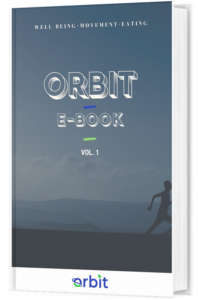Discover the satisfaction means finding the hub of intuitive eating. It is much easier to overeat if you are not satisfied with what you are eating. It is also much easier to take pleasure and feel satisfied in what you are eating if you listen to your body’s desires.
Intuitive Eating1 is a book, created by Evelyn Tribole and Elyse Resch, that presents 10 principles to create a healthy relationship with your food, body, and mind. The 10 principles build upon one another. Work on every principle one by one. If you have not read the Principle #1, Principle #2, Principle #3, Principle #4, or #5 please refer to it before getting into this article.
Satisfaction1
“Fullness is the physical feeling of satiety. Satisfaction is the emotional feeling of satiety.”
Rachel Hartley in The Joy of Eating
Satisfaction is the foundation of all intuitive eating principles. You can follow all the previous principles, but if you are not truly satisfied, you will not be able to eat intuitively.
- Have you ever eaten a piece of fruit when you had a craving for a piece of chocolate? What happened?
Often, if we choose to ignore our craving, we end up overeating, and not feeling satisfied. We may end up eating what we initially were craving, in addition to all the other foods we ate to try to overcome our craving.
Scenario 1-Ignoring Craving:
You feel like eating a chocolate cookie. You ignore this desire and eat an apple. Then, you eat a banana. Then, you go to read your book, still thinking about the cookie. You get up to get some homemade healthy date balls and add some cocoa to add some extra chocolate flavour you are craving. You are full. Nevertheless, you are still craving that chocolate cookie. You end up “giving into” your craving. You go get the box of cookies, and you eat the whole box so fast you don’t even remember how they tasted. Now you feel guilty.
Scenario 2-Listening to Craving:
You feel like eating a chocolate cookie. Then, you get a cookie, sit down calmly, and fully indulge the cookie. You feel satisfied and move on with your day.
If you are not satisfied with the food you eat, your body will do everything it can to have what it really wants.
- When was the last time your felt satisfied by the meal you ate?
Pleasure1
Eating is meant to be a pleasurable experience. This is often forgotten in North America.
We often find ourselves eating a delicious dessert with friends, and all we hear is: “I wasn’t planning on doing a workout this afternoon, but I guess I will now”, or “why did you make something so “bad”?”, or “okay, today is a cheat day!” The dessert is accompanied by so many guilt driven comments that we forget to taste the dessert and enjoy it.
- When was the last time you experienced pleasure, without guilt, with the food you ate?
- Think about meal in which you experienced pleasure. What were you eating? Who were you with?
“When you allow yourself pleasure and satisfaction from every possible eating experience, your total quantity of food will decrease”
(Tribole & Resch, 2012, pp.136)
Creating the Perfect Eating Zone1,3
1. Take the time to eat, without distractions2
In cities, such as Madrid, in Spain, the whole city shuts down for lunch. In part, to allow people to take a nap, but also to allow them to take the time to eat. Within our society, it is praised to eat lunch while working. The more we work, the better. However, we often to not derive that satisfaction from eating in front of a screen.
Try to eat without distractions at least one meal per day. Ideally, you will want to allocate 15 to 20 minutes per meal. This will allow you to take the time to eat slowly and savour the flavours of your food.
Research has shown that eating without distractions caused participants to feel more full after the meal and to eat less. Reversely, research has shown that people who ate with distractions felt less full after the meal, ate more, and were more likely to forget what they ate.
2. Create a Pleasant Eating Environment
- Lighting:
Turn on some lights if you want to heighten the energy during the meal. Or, light some candles if you want more of a romantic ambiance.
- Set the Table:
Create an eating space in a designated area. The designated area can be identified by using place mats, or a tablecloth. Clearing the table of distractions will help you identify the area and get into the eating zone. You may choose to set the table nicely with flowers in front of your meal.
- Comfort:
Eat while sitting in front of a table rather than standing in front of the fridge. Make sure you are comfortable before beginning to eat.
- Use a Plate:
Remove the food from the container or packaging before snacking on it. Eat the food from a plate, rather than directly from the container.
- Take a breath:
Take two or three deep breaths before beginning to eat. Relax, and focus on the meal.
3. Eat When Slightly Hungry
Eating when you are slightly hungry, yet not ravenous, will significantly increase the pleasure, and satisfaction derived from your meal. Similarly, if you are not hungry when you begin your meal, it may also be a less enjoyable experience.
Our ability to eat slowly is impeded if we are ravenous when beginning a meal. Our ability to feel our fullness is also impeded if we begin eating when we do not yet feel our hunger.
4. Avoid Conflicts during Meals
Have you ever felt frustrated during a meal?
I have, and I know it didn’t make it a satisfying eating experience. My hunger was suppressed, my focus was on the frustration, and I was barely able to taste the food.
If you plan to have a heated discussion, maybe save some time after the meal to talk with the person in question.
5. Eat a Variety of Foods
Keeping a variety of foods in your house will allow you to access to the food you want to eat, when you want them.
Most people do not feel like eating the same thing everyday if they take the time to think about what they want. There is a reason we do not want the same food everyday. Our bodies need a variety of fruits, of veggies, of fats, of protein, of complex carbs to keep running. What we feel like eating, or what we crave is often related to what our bodies need. Listening to your body allows you to meet those needs, naturally.
Reconnecting with the Pleasure of Eating1,3
1. Ask yourself: “What do I really feel like eating?”
Giving yourself unconditional permission to eat allows you to ask yourself what you truly feel like eating.
When you have decided what you want to eat, make yourself comfortable, and enjoy that meal.
Fad diets have so many rules telling us what to eat that we forget what we truly like and dislike.
Sit down, and write down the responses to these questions:
- Favorite foods?
- Foods you dislike?
- Favorite food texture?
- Textures you dislike?
- Food you eat, but don’t truly enjoy?
Take the time to think about foods you had been restricting, and perhaps binging. What do you like about that food? Sometimes, you may find yourself binging on a food you don’t even like!
2. Savour the Sensual Features of Your Food
We often think about food before and after eating it and forget to fully focus on the food while we are eating it! When eating, place your focus on the:
Taste
- Humans are generally able to distinguish 5 different flavours, that is:
- Sweet
- Salty
- Umami (savory)
- Sour
- Bitter
Tip: Place different types of foods on your tongue throughout the day. Notice which tastes you truly enjoy at different moments in the day. Remember that your taste buds are on your tongue, so the faster you swallow, the less time you have to taste.
Texture
What is the texture?
- 1. Crunchy
- 2. Creamy
- 3. Smooth
- 4. Lumpy
- 5. Crispy
- 6. Crumbly
- Hard
- 7. Though
- 8. Chewy
Throughout the day, also consider what texture you enjoy at different times.
Tip: When placing different types of foods on your tongue, also notice which textures you truly enjoy at different moments in the day. Are there some you do not enjoy?
Aroma
- Are there any smells you truly dislike, or like in foods?
- Are there aromas you only like at specific times in the day?
- How do the smells affect your desire to eat?
Tip: Before putting something into your mouth, take 5 seconds to smell the food.
Temperature
- You may not feel like eating a hot soup after having gone for a run, just as you may not feel like eating ice cream after a cold ski day. Or, maybe you do!
- Become aware of the temperature of your food, and your temperature preferences at different given times in your day.
Tip: When eating something, think about what temperature the food is.
Appearance
- This is an important one! Having a meal that looks delicious to your eyes might completely change the way it tastes, and the way you feel about it.
- Going to a restaurant is often such a pleasant experience due to the appearance of the plate. This can also be done at home! Adding some herbs on top of your meal, setting the table, or nicely placing your food on a plate can completely change your eating experience.
Tip: Before beginning a meal, make sure you are visually satisfied by the appearance of the food.
3. Check-In with Yourself: Before, during, and after3
Pay attention to how you feel before, during, and after a meal, or snack.
Before:
- How hungry am I? Should start eating at a 3, or 4 according to the hunger/fullness scale.
- What do I feel like eating? Think about texture, flavour, aroma, temperature.
During:
- Does the food taste as good as you expected?
- Are the sensual qualities of the food what you expected?
- What sensual qualities of the food are the most satisfying?
- Are you still hungry?
You may notice that the flavour of a food is better at the first bite than it is at the last bite. Make sure you love every bite you take. Resch and Tribole (2012) say to adopt the motto:
“If you don’t love it, don’t eat it, and if you love it, savor it.” (p.143)
Sometimes, your meal or snack may not be perfect. If you are not enjoying your granola bar, but it is your only option, and you are hungry, then eat the granola bar. However, if you do have access to options, adopt the motto!
After:
- Where am I at on the hunger/fullness scale? Consider stopping at 6 or 7.
- Am I truly satisfied?
- What did I love or dislike about the meal?
- Was I able to stop eating what I disliked?
Important to note:
That every day is different. Our body’s hormonal changes cause us to have fluctuating levels of hunger and fullness. Thus, the importance of checking in with yourself every time you eat.
People experiencing periods go through different phases in which leptin (the hormone telling us we are full) levels vary. For example, research shows that during the luteal phase (where premenstrual symptoms appear), when leptin levels are low, and estrogen levels are high, people tend to have increased cravings for sweet and carb rich foods.
In conclusion, there is a reason your body craves some food. Listen to your body’s cravings.
Next Step: Read Principle #7: Cope with your Emotions without Using Food
References
1Tribole, E., & Resch, E. (2012). Intuitive eating: A revolutionary program that works. St Martin’s Press





